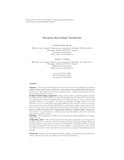| dc.contributor.author | Henry, Christopher | |
| dc.contributor.author | Peters, James F. | |
| dc.date.accessioned | 2019-08-27T19:49:41Z | |
| dc.date.available | 2019-08-27T19:49:41Z | |
| dc.date.issued | 2010-08-24 | |
| dc.identifier.citation | Henry, Christopher, and James F. Peters, "Perception-based image classification: Framework for perception-based cybernetics." International Journal of Intelligent Computing and Cybernetics 3 (3) (2010): 410-430. DOI: 10.1108/17563781011066701. | en_US |
| dc.identifier.issn | 1756-378X | |
| dc.identifier.uri | http://hdl.handle.net/10680/1731 | |
| dc.description | Preprint version | en_US |
| dc.description.abstract | Purpose: The purpose of this paper is to present near set theory using the perceptual indiscernibility and tolerance relations, to demonstrate the practical application of near set theory to the image correspondence problem, and to compare this method with existing image similarity measures. § Design/methodology/approach: Image-correspondence methodologies are present in many systems that are depended on daily. In these systems, the discovery of sets of similar objects (aka, tolerance classes) stems from human perception of the objects being classified. This view of perception of image-correspondence springs directly from Poincaré's work on visual spaces during 1890s and Zeeman's work on tolerance spaces and visual acuity during 1960s. Thus, in solving the image-correspondence problem, it is important to have systems that accurately model human perception. Near set theory provides a framework for measuring the similarity of digital images (and perceptual objects, in general) based on features that describe them in much the same way that humans perceive objects. § Findings: The contribution of this paper is a perception-based classification of images using near sets. § Originality/value: The method presented in this paper represents a new approach to solving problems in which the goal is to match human perceptual groupings. While the results presented in the paper are based on measuring the resemblance between images, the approach can be applied to any application that can be formulated in terms of sets such that the objects in the sets can be described by feature vectors. | en_US |
| dc.description.sponsorship | "This research has been supported by the Natural Sciences & Engineering Research Council of Canada (NSERC) grant 185986, Manitoba Centre of Excellence Fund (MCEF) grant, Canadian Arthritis Network grant SRI-BIO-0 and a NSERC Postgraduate Fellowship." | en_US |
| dc.description.uri | https://www.emerald.com/insight/content/doi/10.1108/17563781011066701 | en_US |
| dc.language.iso | en | en_US |
| dc.publisher | Emerald Insight | en_US |
| dc.rights | info:eu-repo/semantics/openAccess | en_US |
| dc.subject | Image processing | en_US |
| dc.subject | Classification | en_US |
| dc.subject | Perception | en_US |
| dc.title | Perception-based image classification: Framework for perception-based cybernetics | en_US |
| dc.type | Article | en_US |
| dc.identifier.doi | 10.1108/17563781011066701 | en_US |

